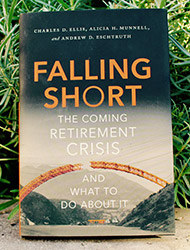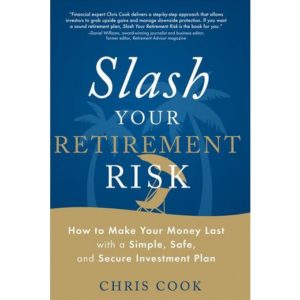 Contrary to what some may feel, equities in retirement is not an oxymoron. If you’re retired or almost so, you may be thinking it’s time to lighten up on your equity exposure.
Contrary to what some may feel, equities in retirement is not an oxymoron. If you’re retired or almost so, you may be thinking it’s time to lighten up on your equity exposure.
The problem with rules of thumb is that some of them get quite dated and nowhere is this more relevant than in the maxim that a retiree’s fixed income exposure should equal their age. (So, the guideline goes, 60 year olds would be 40% in stocks and 90 year olds only 10% in them).
My latest MoneySense Retired Money column looks at this in some depth, via reviews of two books that tackle both the looming North American retirement crisis and this topic of how much equity retiree portfolios should hold. You can find the full article by clicking at the highlighted text: How to Boost Your Returns in Retirement.
As the piece notes, the single biggest fear retirees face is the prospect of outliving your money. Unfortunately, retiring in this second decade of the 21st century poses challenges for just about any healthy person who lacks an inflation-indexed employer-sponsored Defined Benefit (DB) pension plan. We’re living longer and interest rates are still mired near historic lows after nine long years.
The two books surveyed are Falling Short, by Charles Ellis, and Chris Cook’s Slash Your Retirement Risk. I might add that regular Hub contributor Adrian Mastracci twigged me to the Ellis book when he compared and contrasted it to my own co-authored book, Victory Lap Retirement. See Adrian’s review here: Two notable books to guide your “Retirement” journey.
 Falling Short (Oxford University Press, 2014) is Ellis’s diagnosis of and prescription for surviving what he calls “The Coming Retirement Crisis.” He starts by positing what many on-the-cusp-of-retiring baby boomers already suspect: that the “golden age” of retirement enjoyed 30 years ago, including by their own parents, is mostly now a thing of the past.
Falling Short (Oxford University Press, 2014) is Ellis’s diagnosis of and prescription for surviving what he calls “The Coming Retirement Crisis.” He starts by positing what many on-the-cusp-of-retiring baby boomers already suspect: that the “golden age” of retirement enjoyed 30 years ago, including by their own parents, is mostly now a thing of the past.
The average retirement age for American men is now 64 (my age) and 62 for women, which means the average man will spend 21 years in retirement and woman 23 years.
Sadly, Ellis provides only three options: accept that we are going to be poor in retirement, save more while working, or work longer, which of course means fewer years of retirement. Ellis’s solution to the retirement crisis is a combination of working longer and saving more, which is pretty much the gist of Victory Lap Retirement. He suggests that 70 is the new 65 and that Americans should defer receipt of Social Security benefits until age 70, at which time your benefits will be significantly enhanced. The same goes in Canada with CPP and OAS, a topic the Hub and my other columns have pointed out several times.
Other retirement authors (like Fred Vettese in the forthcoming Retirement Income for Life ) have described a reverse mortgage as one last-ditch solution to a shortage of retirement income, provided you are a home owner with some equity in the home. By accessing the home’s equity in the form of a jumbo reverse-mortgage, you will receive extra monetary payments each month. On the negative side of reverse mortgage pros and cons, you will wind up owing a lot of interest. However, the positive sides of such a loan are that the loan won’t default unless you leave the home and the other assets of either you or your family members cannot be seized by the lender if repayment isn’t made. Instead, the lender can request the sale of the home and keep money up to the amount still owed under the reverse loan contract.
 Another route to go is to boost your stock-market exposure in your retirement plans. This is the solution taken in the recently published Slash Your Retirement Risk (Career Press, New Jersey, 2017), begins by warning would-be retirees that “You very likely could run out of money in your lifetime.” The solution, according to author Chris Cook, is to invest heavily in equities and only start to dial them back at what many would consider an advanced age. Cook has coined a term he calls the New ROI, which stands for Reliability of Income. In a nutshell. In this low-yield, rising-costs environment, “investors simply can’t afford NOT to invest in equities with their high-growth potential.”
Another route to go is to boost your stock-market exposure in your retirement plans. This is the solution taken in the recently published Slash Your Retirement Risk (Career Press, New Jersey, 2017), begins by warning would-be retirees that “You very likely could run out of money in your lifetime.” The solution, according to author Chris Cook, is to invest heavily in equities and only start to dial them back at what many would consider an advanced age. Cook has coined a term he calls the New ROI, which stands for Reliability of Income. In a nutshell. In this low-yield, rising-costs environment, “investors simply can’t afford NOT to invest in equities with their high-growth potential.”
Even for investors between the ages of 65 and 71, Cook suggests stock allocations of well over 50%, and in some cases as much as 94 to 97%. If your objective is to adhere to the 4% rule (See my Retired Money column on the 4% rule), then Cook suggests 94% stocks, falling to 86% at 66, 79% at 67 and so on, falling to 30% at 75, 20% at 77, 9% at 80 and not becoming zero until age 83. If you want 4.5% annual income from a portfolio, then he suggests 97% stocks at 71, falling to 61% at 75, 26% at 80, hitting zero at age 86. And if you want 5% per annum, it’s 98% stocks at age 75, falling to 47% at 80 and so on.
While he claims not to be a proponent of market timing, Cook advocates staying fully invested in the market until there a 10% correction in the S&P500 index. If that happens, you retreat to cash (since half the time 10% corrections turn into 20%-plus bear markets).



They don’t understand that the erosion by fee drip will leave them much poorer than there broker sales person.
And they don’t understand how neglgient oversight is and the need to press parliament for better
The normal advice as to what percentage to withdraw from a portfolio to live on. Eg four percent. Did that include the fee drain for advice and services. So that the retiree really shoulb de withdrawing say 2.5 percent to make allowance for this so the fund lasts a tad longer?
Cook’s advice seems to leave a retiree more prone to early sequence of return risk associated with the 4% rule. IIRC, Wade Pfau wrote an article suggesting starting with a lower equity mix to reduce early sequence of return risk and gradually increasing the equity mix.